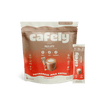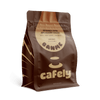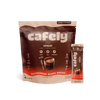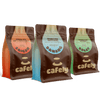Cold brew coffee takes time and patience to brew, but the method is (more or less) foolproof. This coffee is bold, chilled, and low-acidity.
In this article, you’ll learn about cold brew coffee, its origins, benefits, and how to make it…
What is Cold Brew Coffee?
Cold brew coffee is a chilled caffeinated beverage made by steeping ground coffee in cold water for an extended period — usually 18 to 24 hours. This cold extraction process produces a brew with low acidity and a high caffeine content.
Because the coffee is steeped for a long period, cold brew has a naturally sweet and mellow flavor with a reduced bitterness compared to hot-brewed coffee.
Cold brew is often served over ice and is consumed black for its complex, delicate flavors and potential health benefits. However, it can be combined with milk, sugar, or flavored coffee syrups to create an indulgent, creamy iced beverage.
Cold brew can also be made as a concentrate by increasing the coffee-to-water ratio. This way, it can be diluted with water or milk easily or consumed as a strong, cold shot.
What Does Cold Brew Coffee Taste Like?
Cold brew coffee has a smooth, naturally sweet, bold flavor with minimal acidity or bitterness. The cold extraction process used to make cold brew coffee enhances certain flavor notes while dulling down the harsh, sour, and bitter tones that are often found in hot-brewed coffee.
Here are some common flavor notes of cold brew coffee:
- Bold & Rich — Deep coffee taste and dark notes without burnt flavors.
- Smooth & Mellow — Less bitter and lower acidity than hot-brewed coffee. Smooth and mellow flavor without sour or bitter notes.
- Naturally Sweet — Sweet caramel flavors without the bitterness of hot-brewed coffee.
- Nutty & Chocolatey — Nutty, chocolatey, slightly woody tones (depending on the beans used).
- Fruity and Floral — Bright, floral, fruit notes when arabica coffee is used, especially Indonesian varieties.
What Are the Benefits of Cold-Brewed Coffee?

Cold-brewed coffee is no better than hot-brewed coffee — they both offer several benefits. However, cold brew coffee does offer certain lifestyle, flavor, caffeine, and health benefits that hot-brewed coffee doesn’t.
Here are some of the main benefits of cold brew coffee:
1. Lower Acidity
Cold-brewed coffee has significantly lower acidity compared to traditional hot-brewed coffee made using a drip coffee maker, pour-over, French press, or espresso machine. Cold brew coffee is around 67% less acidic than regular hot-brewed coffee, but it does have around 20% fewer antioxidants [1].
The cold extraction process prevents many of the acidic compounds from the coffee beans from being released, which results in a smoother, less harsh taste. This is especially beneficial for people with acid reflux, chronic heartburn, or stomach sensitivity issues.
The lower acidity of cold brew coffee may also be better for the teeth. Acidic beverages with high pH values, such as hot-brewed coffee and Coca-Cola, can contribute to enamel erosion [2].
2. Higher Caffeine Content
Cold-brewed coffee has a significantly higher caffeine content compared to hot-brewed coffee. This can provide a stronger caffeine kick when you need it most and more sustained energy throughout the day.
Caffeine has been linked to improved cognitive function, enhanced memory, and increased metabolism — potentially aiding in weight management [3]. However, people with caffeine sensitivity or issues relating to blood pressure and heart health should be mindful of portion sizes when drinking cold brew.
3. Naturally Sweeter & Less Bitter
Most of the bitter compounds in coffee are extracted at high temperatures toward the end of the extraction process. The cold brewing process extracts far fewer of these compounds due to the low water temperature. This results in a coffee that is naturally smooth, mellow, and sweet.
The natural sweetness of cold brew coffee may help people reduce their overall sugar intake because it’s sweet enough to enjoy without additional sugar or artificial sweeteners.
For people who are conscious about their diet and weight, switching to cold brew could help them cut back on unnecessary calories while still enjoying a sweet morning brew.
4. Longer Shelf Life
Unlike hot-brewed coffee, which can become stale in a matter of hours, cold brew coffee can be stored in the fridge without ruining its flavor for one to two weeks. This makes cold brew coffee a great option for meal-prepping coffee lovers.
Brewing cold brew coffee in bulk eliminates the daily hassle of brewing — perfect for people with busy schedules who want to grab a quick cup on the way to work in the morning. Having a jug of cold brew coffee constantly on hand could also prevent reliance on store-bought coffees, providing convenience, saving money, and being a healthier alternative.
Cold Brew vs. Iced Coffee: The Differences

Although cold brew and iced coffee are both chilled beverages made using coffee, they're brewed differently, leading to distinct flavors, caffeine levels, and acidity.
Cold brew coffee is made through cold extraction, where coffee grounds are steeped in cold water for 18 to 24 hours. Iced coffee is made by brewing hot coffee and cooling it over ice. These two brewing methods produce remarkably different characteristics.
Here's how cold brew and iced coffee differ:
|
Feature |
Cold Brew Coffee |
Iced Coffee |
|
Brewing Method |
Brewed with cold water for 18–24 hours. |
Brewed hot, then cooled and poured over ice. |
|
Flavor |
Smooth, mellow, bold, and naturally sweet. |
Bright, crisp, rich, and slightly acidic. |
|
Acidity |
Low acidity (around 60% less than hot-brewed coffee). |
Higher acidity — the same as regular coffee. The acidity can vary depending on the brewing method used. |
|
Bitterness |
Minimal bitterness. |
More pronounced bitterness. |
|
Caffeine Content |
Much higher — 90–200 mg per cup. |
Lower — 60–150 mg per cup (depends on brewing method). |
|
Serving Style |
Often served black and unsweetened over ice. |
Often served sweetened with milk over ice. |
What Do You Need to Make Cold Brew Coffee?
You don’t need much to make cold brew coffee.
Here are the tools and ingredients needed to make cold brew coffee at home:
Tools Needed
- French Press — This immersion brewer provides an easy way to separate the grounds from the brew. If you don't have one, you can use a jug for brewing and a pour-over for straining.
- Coffee Grinder — The best cold brew is made with freshly ground coffee. Grind whole beans yourself using a coffee grinder.
- Coffee Measure — You'll need a coffee measure or weighing scale to portion your coffee accurately.
- Refrigerator — Cold brew requires refrigeration during the long steeping process.
- Serving Glass — Use a glass to serve the cold brew.
Ingredients Needed
- High-Quality Coffee — Use high-quality whole-bean coffee to make cold brew coffee.
- Water — Opt for cold, fresh, filtered water for the cleanest cold brew.
- Ice (Optional) — Add ice to your glass before serving to keep your brew perfectly chilled.
Coffee Recommendations
We recommend using a high-quality, freshly roasted, whole-bean coffee to make cold brew. Grinding whole-bean coffee just before brewing produces a much more complex, delicate flavor compared to using pre-ground coffee.
The type of coffee you use to make cold brew depends on your taste.
Opt for a 100% arabica coffee such as DaLat to produce a smooth, sweet, bold cold brew with a mild bitterness and caffeine content.
Select a 100% robusta coffee such as HaNoi blend for a rich, dark coffee with a strong bitterness and caffeine content.
Choose a well-balanced blend of arabica and robusta, such as traditional blend of DaNang or Saigon OG, if you want a smooth, balanced flavor that combines the qualities of both beans.
How to Make Cold Brew Coffee (Step-by-Step)
Cold brew coffee is incredibly simple to make; you could even say it's a "foolproof" brewing method. However, it does require some patience. It takes between 18 and 24 hours for this coffee to brew, so make sure to prepare it a day in advance.
Here’s how to make cold brew coffee step-by-step:
1. Measure and Grind Your Coffee

First, you'll need to measure and grind your coffee to a coarse consistency — similar in texture to unprocessed sea salt. Freshly ground coffee makes the best brew, so we recommend grinding whole-bean coffee yourself. If you don't have access to a coffee grinder, make sure to choose a recently roasted pre-ground coffee.
The amount of coffee you'll need depends on the volume of cold brew you wish to make. A 1:8 coffee-to-water ratio is required for cold brew — one part coffee to eight parts cold water.
Use the table below to work out how much coffee and water you need for your desired serving size:
|
French Press Size |
Servings |
Coffee |
Water |
|
3-Cup French Press |
2 servings |
27 grams (5 tablespoons) |
7.5 oz (220 mL) |
|
4-Cup French Press |
4 servings |
45 grams (8–9 tablespoons) |
12 oz (350 mL) |
|
8-Cup French Press |
8 servings |
80 grams (15–16 tablespoons) |
22 oz (650 mL) |
|
12-Cup French Press |
12 servings |
125 grams (23–25 tablespoons) |
34 oz (1000 mL) |
2. Add the Coffee & Water

Next, add your ground coffee to the bottom of your French press. Pour in cold, fresh, filtered water and stir to combine thoroughly, ensuring all the coffee is saturated.
Place the lid on your French press, but do not press the plunger down.
Note: You may need to remove the stem of the plunger to fit the press in your refrigerator.
3. Let the Brew Steep

Now comes the waiting game. Cold brew coffee requires patience. Cold extraction takes a long time.
Place your French press in the refrigerator and forget about it for 18 to 24 hours. Don't worry about stirring the coffee during this period — just let it sit and steep.
4. Strain the Coffee

After 18 to 24 hours, remove the French press from your refrigerator. Slowly press down the plunger to separate the grounds.
If you've made more than one serving, pour the cold brew into a separate, resealable container (a jar or bottle). This will prevent further extraction during storage.
5. Serve and Enjoy

Once you're ready to enjoy a serving of cold brew, add ice to a glass and pour over your coffee. Taste your brew — you may want to adjust it by further diluting it with water, adding a dash of sugar or syrup, or combining it with milk.
Cold brew coffee (without milk and sugar) will keep in the fridge for around five days before its flavor begins to degrade. It's wise to make cold brew coffee in bulk if you plan on consuming it regularly.
FAQs: Cold Brew Coffee
Want to learn more about cold brew coffee and other iced beverages?
Check out the answers to our most frequently asked questions below:
1. What’s the Difference Between Cold Brew and Iced Coffee?
Cold brew coffee is made by extracting the flavors from ground coffee using cold water. The process takes 18 to 24 hours. Iced coffee is made by cooling regular hot-brewed coffee, pouring it over ice, and diluting it with water or milk.
2. How Much Caffeine in Cold-Brewed Coffee?
The amount of caffeine in a cup of cold brew varies depending on the bean type used, the coffee-to-water ratio, and the extraction time. However, the average 8 oz (240 mL) cup of cold brew contains somewhere between 90 and 200 mg. Cold brew made with arabica has a lower caffeine content than cold brew made with robusta.
3. Is Cold Brew Coffee Healthier Than Hot-Brewed Coffee?
Cold brew and hot brew coffee have different characteristics. One is not "healthier" than the other. Cold brew is much less acidic than hot-brewed coffee, which can be better for people with acid reflux. However, it has less antioxidants than hot-brewed coffee. Cold brew also has more caffeine than hot brew. Which brew type suits you best depends on the benefits you desire from a cup of coffee.
4. What’s the Difference Between Cold Brew and Flash Brew Coffee?
Cold brew coffee is made by immersing coffee grounds in cold water for an extended period (up to 24 hours). Flash brew coffee is made by hot-brewing coffee directly over ice using a pour-over setup such as the Hario V60.
5. What is a Frozen Coffee?

Frozen coffee is a chilled beverage that combines coffee, ice, milk, and sugar. These ingredients are blended together to create a thick, slushy, milkshake-like iced coffee.
6. Can You Add Milk to Cold Brew Coffee?
Yes. You can add milk to cold brew coffee to create a creamy chilled beverage. If you plan on making milky iced coffee with cold brew, we recommend increasing the coffee-to-water ratio to create a stronger brew. This way, it can be diluted with milk, but the flavors of the coffee will still shine through.
7. Can You Store Leftover Cold Brew Coffee?
Yes. You can store leftover cold brew coffee in an air-tight container in your refrigerator for around five days before the flavor begins to degrade noticeably. It’s wise to make cold brew in bulk due to its long brew time.
8. What’s the Best Coffee for Cold Brew?
The best coffee for making cold brews should be high-quality and freshly ground before brewing. We recommend a 100% arabica such as DaLat Coffee for a naturally sweet, smooth, mellow brew. Robusta and blends can be used to create a darker, more intense brew.
9. What’s the Best Grind Size for Cold Brew Coffee?
The best grind size for cold brew coffee is coarse — similar in consistency to table salt. This grind size ensures even extraction through the long, cold brewing process.
10. What is Vietnamese Iced Coffee?
Vietnamese iced coffee is a Southeast Asian coffee beverage that's made with robusta coffee. It combines dark, bold robusta coffee brewed using a phin filter with sweetened condensed milk and ice. It's a strong, sweet, creamy beverage that makes a perfect summertime treat or after-dinner dessert drink.
References
- Rao, N. Z., & Fuller, M. (2018). Acidity and antioxidant activity of cold brew coffee. Scientific Reports, 8(1), 16030.
- Jameel, R. A., Khan, S. S., Rahim, Z. A., Bakri, M. M., & Siddiqui, S. (2016). Analysis of dental erosion induced by different beverages and validity of equipment for identifying early dental erosion, in vitro study. J Pak Med Assoc, 66(7), 843-848.
- Marriott, B. M. (1994). Effects of Caffeine on Cognitive Performance, Mood, and Alertness in Sleep-Deprived Humans. In Food Components to Enhance Performance: An Evaluation of Potential Performance-Enhancing Food Components for Operational Rations. National Academies Press (US).










